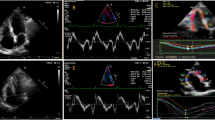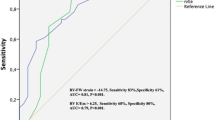Abstract
Right ventricular (RV) myocardial infarction (MI) is a frequent concomitant of an acute inferior MI. We set out to determine the diagnostic value of speckle tracking echocardiography in comparison with cardiac magnetic resonance (CMR) for RV stunning and scar prediction. 55 patients (66 ± 11 years) with an acute inferior ST elevation MI who underwent percutaneous coronary intervention (PCI) of an occlusion in the proximal right coronary artery were prospectively enrolled. An echocardiography was done on the day of presentation and on the 5th day thereafter. A CMR was subsequently performed 1 month after the MI. The CMR was used to differentiate between the group with RV scar (n = 26) and without RV scar (n = 29). RV peak systolic longitudinal strain (RV–LS) at presentation determined RV scar (−21.1 ± 5.1 % vs. −9.9 ± 4.6 %, p < 0.0001). The RV–LS correlated with the scar extent (r = 0.83, p < 0.0001). RV–LS > −15.8 % had a sensitivity of 92 % and a specificity of 83 % in RV scar prediction (AUC 0.93). RV–LS was superior to TAPSE and TDI in determining the presence of RV scar. According to RV–LS values at presentation and on the 5th day, 3 subgroups were defined: G1—normal deformation (RV–LS <−20 %), G2—RV stunning (baseline RV–LS >−20 %, 5th day RV–LS <−20 %) and G3—persistent RV dysfunction (unchanged RV–LS > −20 %). In G1, there was neither RV scar nor clinically relevant hypotension. In G2, 58 % of patients developed RV scar and 36 % had hypotension. In the G3, 83 % developed RV scar and 55 % had hypotension. The myocardial deformation analysis could provide an early prediction of RV scar. It allowed the patients to be divided into subgroups with normal RV function, stunning and persistent RV dysfunction.



Similar content being viewed by others
References
Kakouros N, Cokkinos DV (2010) Right ventricular myocardial infarction: pathophysiology, diagnosis, and management. Postgrad Med J. doi:10.1136/pgmj.2010.103887
Kinch JW, Ryan TJ (1994) Right ventricular infarction. N Engl J Med 330:1211–1217
Isner JM, Roberts WC (1978) Right ventricular infarction complicating left ventricular infarction secondary to coronary heart disease. Frequency, location, associated findings and significance from analysis of 236 necropsy patients with acute or healed myocardial infarction. Am J Cardiol 42:885–894
Piccolo R, Niglio T, Spinelli L et al (2014) Reperfusion correlates and clinical outcomes of right ventricular dysfunction in patients with inferior ST-segment elevation myocardial infarction undergoing percutaneous coronary intervention. Am J Cardiol 114(2):243–249
Goldstein JA (1998) Right heart ischemia: pathophysiology, natural history, and clinical management. Prog Cardiovasc Dis 40:325–341
Mehta SR, Eikelboom JW, Natarajan MK et al (2001) Impact of right ventricular involvement on mortality and morbidity in patients with inferior myocardial infarction. J Am Coll Cardiol 37(1):37–43
Hamon M, Agostini D, Le Page O et al (2008) Prognostic impact of right ventricular involvement in patients with acute myocardial infarction: meta-analysis. Crit Care Med 36(7):2194–2195
Lang RM, Bierig M, Devereux RB et al (2006) Recommendations for chamber quantification. Eur J Echocardiogr 7:79–108
Rudski LG, Lai WW, Afilalo J et al (2010) Guidelines for the echocardiographic assessment of the right heart in adults: a report from the American Society of Echocardiography endorsed by the European Association of Echocardiography, a registered branch of the European Society of Cardiology, and the Canadian Society of Echocardiography. J Am Soc Echocardiogr 23(7):685–713
DeLong ER, DeLong DM, Clarke-Pearson DL (1988) Comparing the areas under two or more correlated receiver operating characteristic curves: a nonparametric approach. Biometrics 44:837–845
Andersen HR (1987) Right ventricular infarction: frequency, size and topography in coronary heart disease: a prospective study comprising 107 consecutive autopsies from a coronary care unit. J Am Coll Cardiol 10:1223–1232
Kumar A, Abdel-Aty H, Kriedemann I et al (2006) Contrast-enhanced cardiovascular magnetic resonance imaging of right ventricular infarction. J Am Coll Cardiol 48(10):1969–1976
Jensen CJ, Jochims M, Hunold P et al (2010) Right ventricular involvement in acute left ventricular myocardial infarction: prognostic implications of MRI findings. Am J Roentgenol 194(3):592–598
Cameli M, Lisi M, Righini FM et al (2012) Right ventricular longitudinal strain correlates well with right ventricular stroke work index in patients with advanced heart failure referred for heart transplantation. J Card Fail 18:208–215
Meluzin J, Spinarova L, Bakala J et al (2001) Pulsed doppler tissue imaging of the velocity of tricuspid annular systolic motion; a new, rapid, and noninvasive method of evaluating right ventricular systolic function. Eur Heart J 22:340e8
Witt N, Alam M, Svensson L et al (2010) Tricuspid annular velocity assessed by doppler tissue imaging as a marker of right ventricular involvement in the acute and late phase after a first ST elevation myocardial infarction. Echocardiography 27(2):139–145
Horton KD, Meece RW, Hill JC (2009) Assessment of the right ventricle by echocardiography: a primer for cardiac sonographers. J Am Soc Echocardiogr 22:776e92
Alam M, Wardell J, Andersson E et al (2000) Right ventricular function in patients with first inferior myocardial infarction: assessment by tricuspid annular motion and tricuspid annular velocity. Am Heart J 139(4):710–715
Smarz K, Zaborska B, Jaxa-Chamiec T et al (2012) Right ventricular dysfunction and exercise capacity after inferior (Posterior) wall acute myocardial infarction. Am J Cardiol, Epub ahead of print on http://dx.doi.org/10.1016/j.amjcard.2012.05.007
Galderisi M, Severino S, Cicala S, Caso P (2002) The usefulness of pulsed tissue doppler for the clinical assessment of right ventricular function. Ital Heart J 3:241e7
Ozdemir K, Altunkeser BB, Içli A et al (2003) New parameters in identification of right ventricular myocardial infarction and proximal right coronary artery lesion. Chest 124:219–226
Kidawa M, Kasprzak JD, Wierzchowski T, Krzeminska-Pakula M (2010) Right ventricular function suffers from reperfusion delay: tissue Doppler study. Clin Cardiol 33(3):E43–E48. doi:10.1002/clc.20582
Kidawa M, Chizyński K, Zielińska M, Kasprzak JD, Krzeminska-Pakula M (2013) Real-time 3D echocardiography and tissue doppler echocardiography in the assessment of right ventricle systolic function in patients with right ventricular myocardial infarction. Eur Heart J Cardiovasc Imaging 14(10):1002–1009
Mondillo S, Galderisi M, Mele D et al (2011) Speckle-tracking echocardiography: a new technique for assessing myocardial function. J Ultrasound Med 30:71e83
Roca GQ, Campbell P, Barst R et al (2012) Right ventricular longitudinal strain correlates with cardiopulmonary hemodynamics and NT-proBNP in pulmonary arterial hypertension. J Am Coll Cardiol 59:E1285. doi:10.1016/S0735-1097(12)61286-8
Horton KD, Meece RW, Hill JC (2009) Assessment of the right ventricle by echocardiography: a primer for cardiac sonographers. J Am Soc Echocardiogr 22:776e92
Hoogslag GE, Haeck ML, Velders MA et al (2014) Determinants of Right Ventricular Remodeling Following ST-Segment Elevation Myocardial Infarction. Am J Cardiol S0002–9149(14):01700–01707. doi:10.1016/j.amjcard.2014.08.006
Meris A, Faletra F, Conca C et al (2010) Timing and magnitude of regional right ventricular function: a speckle tracking-derived strain study of normal subjects and patients with right ventricular dysfunction. J Am Soc Echocardiogr 23(8):823–831
Teske AJ, De Boeck BWL, Olimulder M et al (2008) Echocardiographic assessment of regional right ventricular function: a head-to-head comparison between 2 dimensional and tissue doppler-derived strain analysis. J Am Soc Echocardiogr 21:275–283
Motoji Y, Tanaka H, Fukuda Y, Ryo K, Emoto N, Kawai H, Hirata K (2013) Efficacy of right ventricular free-wall longitudinal speckle-tracking strain for predicting long-term outcome in patients with pulmonary hypertension. Circ J 77(3):756–763 Epub 2012 Dec 7
Inohara T, Kohsaka S, Fukuda K, Menon V (2013) The challenges in the management of right ventricular infarction. Eur Heart J Acute Cardiovasc Care 2(3):226–234
Piccolo R, Niglio T, Spinelli L et al (2014) Reperfusion correlates and clinical outcomes of right ventricular dysfunction in patients with inferior ST-segment elevation myocardial infarction undergoing percutaneous coronary intervention. Am J Cardiol 114:243–249
Acknowledgments
Authors received the grant support IGA MH CR NT14288-3/2013.
Author information
Authors and Affiliations
Corresponding author
Rights and permissions
About this article
Cite this article
Hutyra, M., Skála, T., Horák, D. et al. Echocardiographic assessment of global longitudinal right ventricular function in patients with an acute inferior ST elevation myocardial infarction and proximal right coronary artery occlusion. Int J Cardiovasc Imaging 31, 497–507 (2015). https://doi.org/10.1007/s10554-014-0573-y
Received:
Accepted:
Published:
Issue Date:
DOI: https://doi.org/10.1007/s10554-014-0573-y




